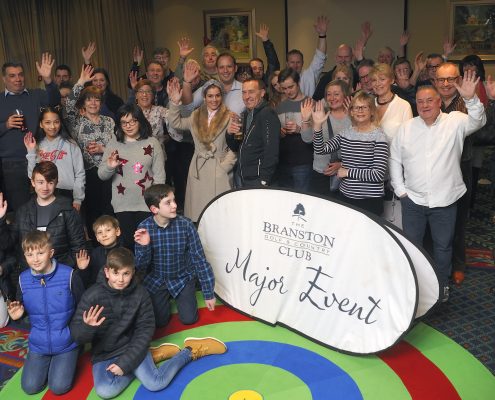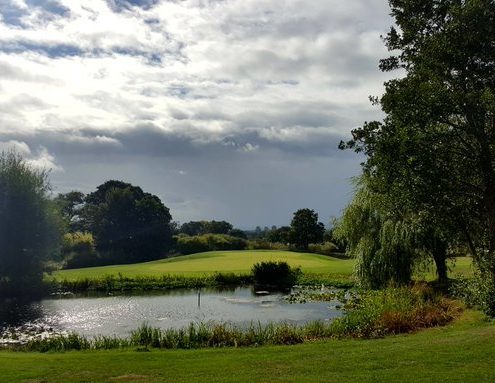Evolution of Golf – Are we getting it?
Our major two-part survey focusses firstly on the issue we’re all familiar with at present.
We’re forever being told that golf is in decline, with falling membership numbers and clubs facing closure and financial difficulties as a result.
But whilst acknowledging that facts don’t lie and there’s a significant battle to fight to defend our great game’s future, MG and our friends at the Golf Management Group are seeing positive ideas coming to fruition at our region’s clubs and organisations that are potentially paving the way to a brighter future and most importantly encouraging new players into the game.
The keyword is modernisation which may not sit too well with everybody, but things may be ain’t all as bad as they seem, as long as the weather doesn’t scupper us, maybe there are some welcome green shoots of recovery.
Have we reached a tipping point now where the stark reality for clubs is – change our ways or fade away?
We want to know what you, the readers and Midlands golfers think. We’ve set six multiple-choice questions for you here. Closing date for the survey is Friday March 20th, we will publish the results in our April ‘Masters’ issue.
We have a prize element to this as well. All survey contributors will go into a hat and the first three drawn out at the end of March will win a golfing gift from the MG prize table.
By answering the following questionnaire you will be entered into a prize draw, and accepting our Terms and Conditions
The Mark Stancer column
I was intrigued when the editor of Midlands Golfer, Phil Nicholas, informed me early in the New Year that the magazine would be running a survey aimed at helping us all understand further how we can improve this wonderful sport of ours.
The most important lesson I have learned from 41 years in the business stems from two golden rules: Customer service is everything and your members will be your best salesmen, but only if they are happy.
The late great football manager Bill Shankly, founding father of a success story currently being regenerated at Liverpool FC, was fond of saying simplicity is genius.
He was on the money there and if a golf club simply gets its priorities right, it will not need to chase new members. Your existing members will eagerly renew their subscriptions and recommend the club far and wide.
Yet only if it is their “Happy Place”. Time spent at a golf club should be joyous and full of glorious memories. It’s time spent pursuing a passion.
It might be leisure time away from the home and family. If you prefer, your passion can be time spent with your family. What’s not to like either way?
Most golf club members need to see as many visiting players enjoy the course as their club can comfortably accommodate to keep the cost of their subs down. Or, in some cases, to keep their club in existence.
You think that is simplistic and obvious? If so, why is the number of UK golfers dwindling? Is it because visitors can be made to feel unwelcome sometimes? Sadly, we all we know the answer to that question.
Crucially (despite what some of the dinosaur minority among members might think to the contrary) no one sort of golfer is more important as a paying customer than any other.
That is the case whether you belong to a club, whether you have joined a society or whether you play golf when and wherever you choose.
It’s a given your course is in tip-top condition, all day every day! So here are eight factors every golf club has to be aware of to survive and prosper . . .
1) BE HAPPY
Always create a warm welcome all the time without exception in the pro’s shop, the clubhouse and on the course. Laugh and the world laughs with you.
2) BE DIFFERENT
While the new Wembley was being built, the England football team played home games at various grounds including St James’ Park in Newcastle. They stayed at Slaley Hall, a golf and leisure resort which has a football training pitch.
At the time Slaley, which is out in the Northumberland wilds, had no junior golfers. During the school summer holidays they combined “Get Into Golf” sessions for youngsters with football coaching “on the pitch used by David Beckham” and advertised in the regional golf magazine and newspapers.
Youngsters came in droves for the football while getting a chance to try golf for the first time. Slaley quickly created a thriving junior golf section and won the county junior league within five years, which is quite some return on advertising investment.
3) MAKE MEMORIES
Ask your membership and pick the brains of staff to get ideas for unexpected events, stunts and experiences. You will soon find out what what you already do well and identify opportunities for improvement.
Introduce the element of surprise into your planning. Create lasting memories of your “Happy Place” which brings your customers back time and time again.
In the clubhouse and on the course, be creative with ideas which encourage golfers to interact such as a barbie at the halfway house, cookery demos and cocktail making lessons.
When was the last time your club hosted a trick show or an an exhibition from a top player, maybe a senior tour player?
It’s affordable, and the player will have entertaining stories to leave a memorable experience with your members thinking “just fantastic”, this is a club that’s trying.” Make the customer journey happy and and it will snowball.
4) PICK A TEAM
Accountants will tell you goodwill does not show on your balance sheet. Technically, yes. In reality, all your paid staff and volunteers represent an investment in either time or money or both.
Every team member needs, one way or another, a precise job description to define their exact role in delivering the best customer experiences for members and visitors.
5) CREATE CONSISTENCY
All staff need to find a repeating standard for the club and deliver the necessary consistency. Making it happen day to day, come rain or shine, presents its challenges as the team all need to be on the same page and sing from the same hymn sheet all day every day.
6) SPOT TROUBLE
Some roles will be small but significant but you can’t afford to have even one sour face around the place. That’s an expensive liability.
Be highly alert from the start when you recruit. I learned early on when finding new members for a team that while you can train skill, it is much more unlikely you will be able to turn round a bad attitude.
As for any members who put visitors off in any way, you need to find a way of managing those characters even if, after all warnings are ignored, the only way is the highway.
7) GET HELP
There is a lot of complicated paperwork and IT demands created by the variety of tasks involved in running a golf club. Outsource and find assistance with key admin tasks such as Health & Safety, Purchasing and Human Resources.
This will pay dividends by freeing key team members to focus on the things that matter most – exceptional customer service and customer experiences.
There are dedicated golf industry companies who can help you develop and avoid expensive mistakes.
8) MAKE A NOISE
I hire a PR guy for expert publicity advice and copy writing (he’s ghost written this column after interviewing me) as well as doing my own marketing.
If you have members involved in marketing and/or any form of the media ask them to help with publicity and promotions.
Get your message out there. This will add to those member testimonials I mentioned earlier, especially on social media.
Golf is in the entertainment industry. We should all be trying to put on a show, a performance. Do your best to let people know every time the curtain goes up on something new.
*Mark Stancer, a PGA coach and a member of the Golf Club Managers Association, is a director of the Golf Management Group, working with clubs in the Midlands and the South West.
Golf clubs get a free first year’s membership of the Golf Management Group through GMG’s England Golf partnership.
For details, phone Mark Stancer on 07745 861 888 or email mark@golfmanagementgroup.co.uk

Our say
Opinions based on nine years of travelling around the Midlands and beyond, delivering magazines and holding many talks with club managers and golf pros.
On the bright side
We’ve seen enough evidence across the region of new modern schemes that are working well to bring new golfers into the respective golf clubs that have introduced them. We’ve seen more investment in course improvements, drainage issues fixed and clubhouse redevelopments in the last 12-18 months than we were noticing when this magazine started in 2012.
Even though it’s not everyone’s cup of tea, the PlayMore Golf model is doing a good job getting the 20s and 30s playing golf fairly regularly. Eventually, when time allows them to, they could well become 5 or 7-day members again. They have to be the target age group for the future sustainability of golf clubs.
The rise in quality modern indoor facilities for better practice and the sociability and relaxed atmosphere around the development of Toptracer and it’s like to our driving ranges is a great new way of breaking down the barriers and getting young people into golf. The technological age in golf might not be everyone’s cup of tea but the stats cannot be ignored. More people are hitting golf balls.
In our opinion, the desire to go out and play is still there – but we need to modernise the ways in which we offer it, there are encouraging signs that at least some are doing just that.
On the flip side
Unfortunately and we all experience it, there are still golf clubs out there, mostly members clubs it has to be said who are burying their heads in the sand, a little bogged down by over populated committees and resolutions that belong in the dark ages.
One high ranking club official who will remain nameless walked into a local golf retail store just before Christmas and during the chat about the game that followed exclaimed – “junior golfers, we don’t need them, they don’t add anything to our balance sheet.”
Not really strictly true that is it, not much forward-thinking in that statement.
Traditional member’s golf clubs are wonderful establishments with rich histories and proud traditions which we should respect and be thankful for. But the world has changed and so must golf; we are not a sport anymore that people just trundle their way into, the demands of modern life and competition from other pastimes have put paid to that.
Many clubs still have an age demographic for their members which are well into the 60s, that should be enough to set the alarm bells ringing. Where will you be in 20 years?
It’s a big challenge to bring the demographic down but the methods for change are quite straightforward ones, value for money, a suitable and affordable pathway for each new golfer and a friendly way of providing it to blow the pre-conceptions away.
Customer service providers in other industries know how it is and how to adapt to changing times, for the golf clubs in trouble or heading that way – are you truly willing to as well?
Part Two – From green to greener – March 2020
The weather of late has made this forthcoming feature pretty timely – all about golfing environmental concerns and whether you believe in it or not, is golf in The Midlands making enough provisions to counter the threat of climate change?
We’ll be running a couple of case studies from eco-conscious clubs getting ahead of the game and also talking to a number of our local greenkeepers over their potentially changing roles and the new gear coming into the GK sheds.












